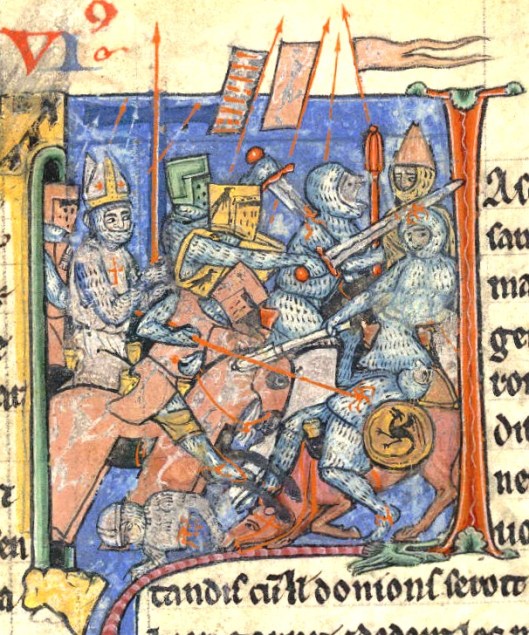
A mitred Adhémar de Monteil carrying the Holy Lance in one of the battles of the First Crusade
Bishop of Le Puy and legate of Pope Urban II during the First Crusade (1096–1099). Adhemar was born in France around 1045, the son of a nobleman from the Valentinois. He may have been a member of the cathedral chapter of Valence; he became known as an advocate of the Gregorian reform movement. About 1079/1080 he was elected bishop of Le Puy. Shortly after 1086, together with Raymond of Saint-Gilles, count of Toulouse, Adhemar called for reinforcements to fight in Spain against the Almoravid caliph Yūsuf.
Before Pope Urban II made his appeal for an expedition to the East at the Council of Clermont (27 November 1095), he had previously contacted Adhemar in the south of France and asked him to act as his representative with the status of legate (Lat. legatus a latere) to administer spiritual support to the crusaders on their expedition to Jerusalem. Adhemar took the cross at the conclusion of Urban’s crusade sermon at Clermont, and left for the East with Raymond of Saint- Gilles in October 1096.
By the time the crusade armies crossed into Asia Minor, Adhemar was recognized as their spiritual head. In addition, as the leading role of the Byzantine emperor in the crusade diminished, Adhemar increasingly came to figure as the military leader of the crusade. An encyclical letter to the West from Adhemar and the patriarch of Jerusalem, Symeon II, dating from the first weeks of the siege of Antioch (autumn 1097–June 1098), reported on the progress of the crusade and urged that all of those who had taken the cross but had failed to set out should be excommunicated unless they had fullfilled their vows by the following Easter. In all probability, Adhemar and Symeon discussed plans for the liberation of the Eastern churches. After the conquest of Antioch, Adhemar reinstated the Greek Orthodox patriarch, John IV Oxeites, and recognized his canonical authority over all clergy in his patriarchate, Latin as well as Greek. Adhemar’s early death on 1 August 1098 during an epidemic made him a near-legendary figure in the perception of his contemporaries. He was buried in the cathedral of Antioch. In 1125 his remains were translated back to a more splendid tomb at Le Puy on the initiative of his successor.
Bibliography Becker, Alfons, Papst Urban II (1088–1099), 2 vols. (Stuttgart: Hiersemann, 1988). Brundage, James A., “Adhémar of Puy: The Bishop and his Critics,” Speculum 34 (1959), 201–212. Hiestand, Rudolf, “Die päpstlichen Legaten auf den Kreuzzügen und in den Kreuzfahrerstaaten vom Konzil von Clermont (1095) bis zum vierten Kreuzzug” (unpublished Habilitationsschrift, University of Kiel, 1972). ———. “Les canons de Clermont et d’Antioche sur l’organisation ecclésiastique des Etats croisés: Authentiques ou faux?,” in Autour de la première croisade, ed. Michel Balard (Paris: Publications de la Sorbonne, 1996), pp. 29–37. Hill, John H., und Laurita L. Hill, “Contemporary Accounts and the Later Reputation of Adhemar, Bishop of Puy,” Medievalia et Humanistica 9 (1955), 30–38. Kirstein, Klaus-Peter, Die lateinischen Patriarchen von Jerusalem (Berlin: Duncker & Humblot, 2002). Mayer, Hans Eberhard, “Zur Beurteilung Adhémars von Le Puy,” Deutsches Archiv für Erforschung des Mittelalters 16 (1960), 547–552. Pahlitzsch, Johannes, “Symeon II. und die Errichtung der Lateinischen Kirche von Jerusalem durch die Kreuzfahrer,” Militia Sancti Sepulcri: Idea e istituzioni, ed. Kaspar Elm and Cosimo Damiano Fonseca (Città del Vaticano: Pontificia Università del Laterano 1998), pp. 341–360. Richard, Jean, “Quelques textes sur les premiers temps de l’église latine de Jérusalem,” Recueil de Travaux offert à M. Clovis Brunel, 2 vols. (Paris: Société de l’Ecole des Chartes 1955), 2:420–430. ———. “La papauté et la direction de la Ière croisade,” Journal des Savants (1960), 49–58. Riley-Smith, Jonathan, The First Crusaders, 1095–1131 (Cambridge: Cambridge University Press 1997).